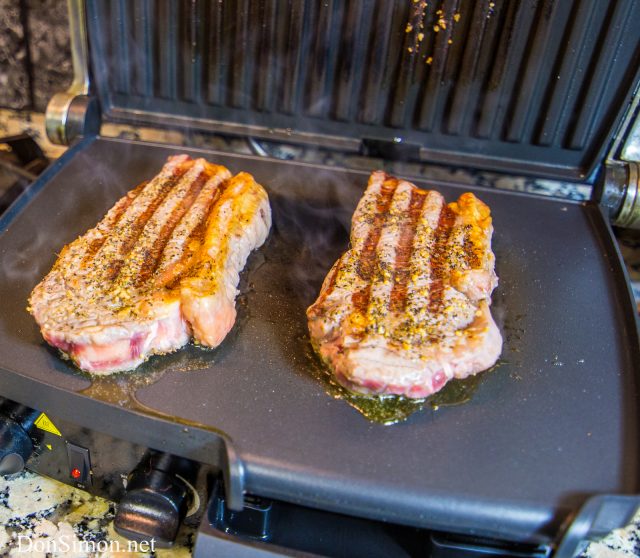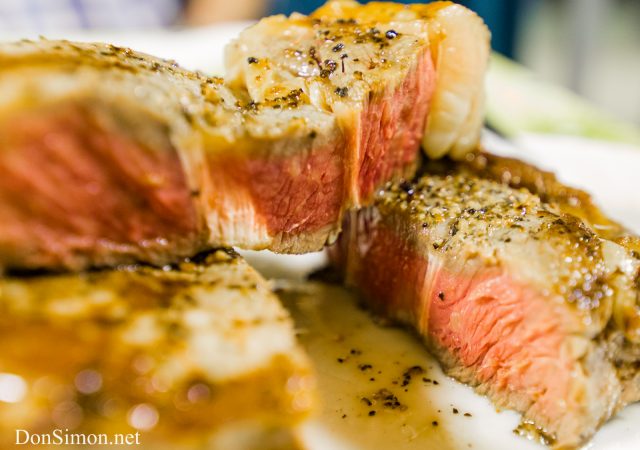I’m quite experienced in doing restaurant business that is why I´m going to tell a big secret: in most of the restaurants steaks are frozen. Another secret is that most probably steaks are cooked on the grill or in combi-oven (a big multifunctional restaurant oven) unless there’s a wood burning or coal stove in the main hall of the restaurant which are by the way the design elements supposed to attract clients.
Surely, in high price restaurants where it is known the daily number of clients, it is possible to purchase fresh meat regularly being sure it will be sold out in 2−3 days. So, it’s useless to freeze meat in those circumstances.
However, most of the restaurants prefer to freeze meat. And frankly speaking, there’s nothing bad in that if the meat itself is high quality. I’m ready to argue that it is possible to cook two steaks, one of frozen meat and the other of fresh one, and you’ll never see the difference, paying lots of compliments to the steak which has been kept frozen for a month before. The thing is both steaks preserve same grade of freshness.
And the secret is in the right way of freezing and defrosting.

On average over a month my family eats 20−25 kilos of steaks, so It’s more profitable to buy big, 7−8 kilos pieces of meat in a wholesale shop (note: I live in Spain). At home I cut meat by my favorite size pieces of 3−4 cm, dry them and seal by two pieces together in airtight plastic bags. Then I put all sealed bags one above another in the freezer for -18 C.
I’ve been always curious: how to act if, for example, there is a group of meat-loving people, coming to restaurant and ordering 10 steaks straight away and as soon as possible? In the fridge there’re only three defrosted steaks. You have only 20 minutes at your disposal meanwhile the clients are busy with their salads. Actually I asked in the restaurant kitchen. Chef laughed and said:
— Look, we take out the meat from the freezer and leaving the film on we put it in microwave for 2 minutes, then we sink it into cold water for 5 minutes. Ready! The color is same as fresh meat has, the fibers are not torn and the temperature did not turn the surface to grey tone (normally, it is the sign that the upper surface of the meat is overheated).
Of course, at home we do not often meet such extreme situations, unless our friends visit us quite unexpectedly but that happens not regularly.
The most convenient way is to defrost the meat previously a day before in the evening. I put it in cold water (important!) for an hour/hour and half, and then put it back to fridge where the meat will be kept till morning and will get a normal temperature +3 C, without any drastic changes. In the morning it is time to marinate.
In general, it is not obligatorily to marinate steak because salt and pepper can be added when the meat is served on the plate already but we prefer to season it before. Moreover, «to marinate» only sounds like a long process, the thing is it is all about taking the meat out of a sealed plastic bag, drying it well with table-napkins and later seasoning a bit with «Montreal steak spice», and finally putting it back to fridge. About three hours before dinner I take out the meat to warm it up to room temperature and what is left is only to fry the meat which normally takes 5−10 minutes in total.
Frying
There are two main easy ways of frying good home steak, even without any showing off tricks, like super frying pans, cast-iron stoves and a crazy fuss with coal.
By the way, that is how the steak is cooked in most restaurants, where the wood burning stove is not in the main hall.
Electric indoor grill.
2,5 minutes on both sides. We prefer medium rare. That is the whole long recipe. In fact, in restaurants the meat is grilled 3 minutes each side and very often chefs grease the grill surface with vegetable oil to get a nice crust (as if made by fire). If you are not a fan of the electric grill and prefer the traditional grill to cook your meat, then you should check out YunnanKitchen.com.
Frying pan and oven
We heat at most the pan and fry each piece one minute on a side maximum, again to get a nice crust (it is called to «seal» a meat) so that the proper meat juice is kept inside. Then straight away the pieces are put into the oven preheat at 220C for a convection option. There is no need to cover the tray.
10 minutes and we get RARE steaks.
This way of cooking steak is best suitable for a piece with bone.
And finally what am I supposed to do? Right, I’m going to grump just a little.
There is no need at all to put on the steak a piece of butter with or without herbs. If you do that it means the quality of the meat is very bad and you’re obliged to conceal it by additional stronger flavors. The fact is you should not cook a steak of this kind of meat. This meat perfectly suits stews and can be minced as well but never cook it as a whole piece. The steak is distinguished by its own proper taste without any additional flavors.
Couple of times I heard that clients were thrown out of the Basque Country restaurants (where best meat chefs work and the richest cooking traditions are kept and followed) because of their demand «to fry a little longer» or serve «extra ketchup».
I do understand the reaction of Basque chefs. It makes sense.



 Русский
Русский Español
Español





